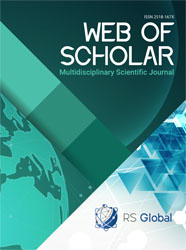SUBMICROSCOPIC CHANGES OF STRUCTURAL COMPONENTS OF THE SPLEEN DUE TO THE ACTION OF MONOSODIUM GLUTAMATE
Abstract
The results of an experimental study conducted on white male rats and females of reproductive age were analyzed in order to detect submicroscopic changes in the structural components of the spleen under the action of monosodium glutamate in the dynamics. For two, four, six and eight weeks, the animals received monosodium glutamate at a dose of 0.07 g / kg body weight daily with food. Sections of the spleen were made on a UMTP-6M ultramicrotome with a diamond knife (DIATOM) and double contrast was performed according to Reynolds and uranyl acetate. Submicroscopic examinations of the organ were performed using an electron transmission microscope TEM-100. The investigated material was photodocuted using a SONY – H9 digital camera. The first violations of the structural components of the spleen are observed after two weeks, namely the expansion of intercellular spaces in both white and red pulp of the spleen, which contain vacuole-like structures, an increase in plasma cells, the cytoplasm of which is filled with dilated tubules. In dynamics with increase in duration of reception changes deepen, reaching a maximum in 8 weeks of experiment. Electron microscopy revealed that the signs of adaptive-compensatory processes by the end of the experiment lead to a loss of regenerative function.
References
Alalwani, A.D. (2014), «Monosodium glutamate induced testicular lesions in rats (histological study)». Middle East Fertil Soc J., 19, 274–80. https://doi.org/10.1016/j.mefs.2013.09.003.
Bandas, I.A., Kulitska, M.I., Korda, M.M. (2017), «Strukturni zminy pechinky, nyrok ta selezinky shchuriv pry dii nanochastynok dioksydu kremniiu ta atsetatu svyntsiu». Visnyk problem biolohii i medytsyny, 1, 322–327. http://nbuv.gov.ua/UJRN/Vpbm_2017_1_70.
Bautista, R.J.H., Mahmoud, A.M., Königsberg, M., Guerrero, N.E.L.D. (2019), Obesity: Pathophysiology, monosodium glutamate-induced model and anti-obesity medicinal plants. Biomedicine & Pharmacotherapy, 111, 503-516. https://doi.org/10.1016/j.biopha.2018.12.108.
Beltiukova, SV. (2016), «Determination of monosodium glutamate thin-layer chromatography method with detection fluorescent». Visnyk ONU. Khimiia.;1 (57), 50–58.
Bobrysheva, I.V. (2013), «Ultramikroskopicheskoe issledovanie selezenki krys raznykh periodov postnatalnogo ontogeneza posle vvedeniia imunofana», Zhurnal Grodnenskogo gosudarstvennogo meditsinskogo universiteta, 4,56–60.
Bulko, I.V. (2016), «Strukturni zminy v selezintsi shchuriv u piznikh stadiiakh opikovoi travmy pislia korektsii infuziinym rozchynom HAES-LX-5%». Visnyk problem biolohii i medytsyny, 360–363.
Ciric, M., Cekic, S., Pavlovic, V., Jovic, Z. and Tasic, G. (2005), «Histopathological changes In spleen of rats treated with monosodium glutamate». Acta Fac. Med. Naiss, 22,191–194.
Ebaid, H.M., Tag, H.M. (2012), «Monosodium glutamate toxic effect on spleen structure and potential of recovery in adult albino rats». Egypt Acad J Biol Sci, 4, 1–8. https://doi.org/10.21608/EAJBSZ.2012.13513.
El-Aziza, R., Naguiba, M., Rashedb, L. (2018), «Spleen size in patients with metabolic syndrome and its relation to metabolic and inflammatory parameters». The Egyptian Journal of Internal Medicine, 30, 78-82. https://doi.org/10.4103/ejim.ejim_86_17.
Eweka, A.O., Eweka, A., Om’iniabohs, F.A.E. (2010), Histological Studies of the Effects of Monosodium Glutamate of the Fallopian Tubes of Adult Female Wistar Rats. North American Journal of Medical Sciences.2010;2(3):146–149. https://doi.org/10.4297/najms.2010.3146.
Eweka, A.O., Om’iniabohs, F.A.E. (2011), «Histological Studies of the Effects of Monosodium Glutamate on the Ovaries of Adult Wistar Rats». Annal of Medical & Health Sciences Research, 1 (1), 37–43.
Gavrylyuk-Skyba, G.O., Volkov, K.S., Nebesna, Z.M. (2013), «Dynamika zmin mikrometrychnykh ta morfometrychnykh pokaznykiv selezinky pislya eksperymentalnoyi termichnoyi travmy». Biomedical and biosocial antropology, 20, 45–48.
Gotoh, K., Inoue, M., Masaki, T., Chiba, S., Shimasaki, T., Ando, H. et al. (2012), «A novel antiinflammatory role for spleen-derived IL-10 in obesity-induced hypothalamic inflammation». J Neurochem, 120, 752–764.
Hashem, H.E., El-Din Safwat, M.D., Algaidi, S. (2012), «The effect of monosodium glutamate on the cerebellar cortex of male albino rats and the protective role of vitamin C (histological and immunohistochemical study)». J Mol Histol. 43 (2), 179–186. https://doi.org/10.1007/s10735-011-9380-0.
Hassan, Z.A., Arafa, M.H., Soliman, W.I., Atteia, H.H., Al-Saeed, H.F. (2014), «The Effects of Monosodium Glutamate on Thymic and Splenic Immune Functions and Role of Recovery (Biochemical and Histological study)». J Cytol Histol, 5, 283. https://doi.org/10.4172/2157-7099.1000283.
Liu, C., Li, M., Cao, Y., Qu, J.P., Zhang, Z.W., Xu, S.W., Li, S. (2014), «Effects of avermectin on immune function and oxidative stress in the pigeon spleen». Chem Biol Interact, 210, 43–50. https://doi.org/10.1016/j.cbi.2013.12.015.
Shemediuk, N.P., Zaitsev, O.O., Butsiak. V.I. (2010), «Histolohichni zminy selezinky, pechinky, nyrok tvaryn za dii bioaktyvnykh rechovyn». Sovremennыe problemы toksykolohyy, 2-3, 54–57.
Voloshin, V.M. (2012), «Vyvchennya ingalyatsiynogo vplyvu epikhlorgidrynu na organometrychni pokaznyky selezinky statevozrilykh shchuriv». Tavricheskiy mediko–biologicheskiy vestnik. 15, 1 (57), 54–57.
Yevlakhova, L.A., Chava, S.V., Akyyeva, N.K. (2013), «Strukturnyye osobennosti beloy pulpy selezyonki u myshey posle radiatsionnogo vozdeystviya nizkoy intensivnosti». Morfologicheskiye vedomosti, 2, 98–100. eLIBRARY ID: 21477954.
Zanfirescu, A., Cristea, A.N., Nitulescu, G.M., Velescu, B.S., «Gradinaru, D. (2018), Chronic Monosodium Glutamate Administration Induced Hyperalgesia in Mice». Nutrients, 10, 1. https://doi.org/10.3390/nu10010001.
Views:
235
Downloads:
222
Copyright (c) 2020 Tetiana Harapko, Lesia Mateshuk-Vatseba

This work is licensed under a Creative Commons Attribution 4.0 International License.
All articles are published in open-access and licensed under a Creative Commons Attribution 4.0 International License (CC BY 4.0). Hence, authors retain copyright to the content of the articles.
CC BY 4.0 License allows content to be copied, adapted, displayed, distributed, re-published or otherwise re-used for any purpose including for adaptation and commercial use provided the content is attributed.











